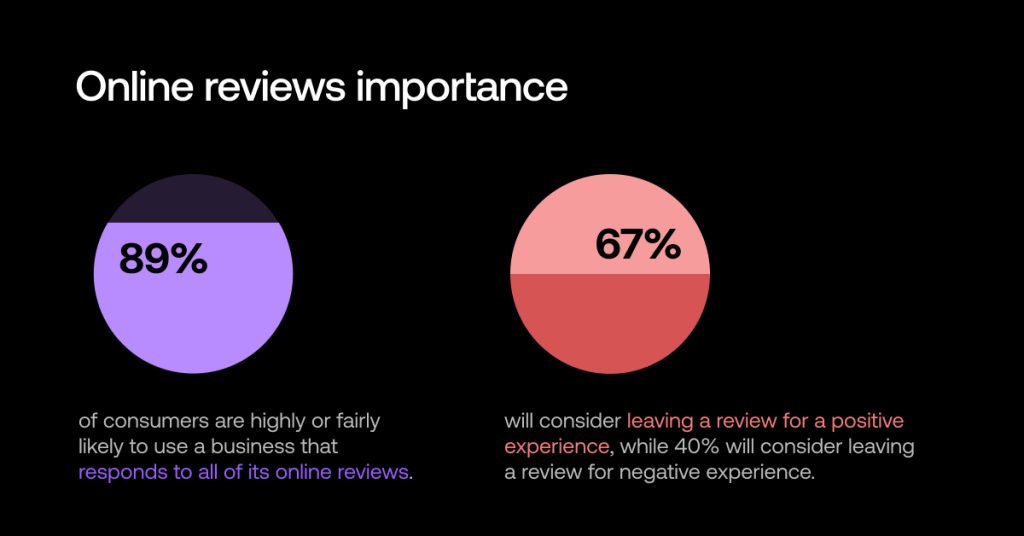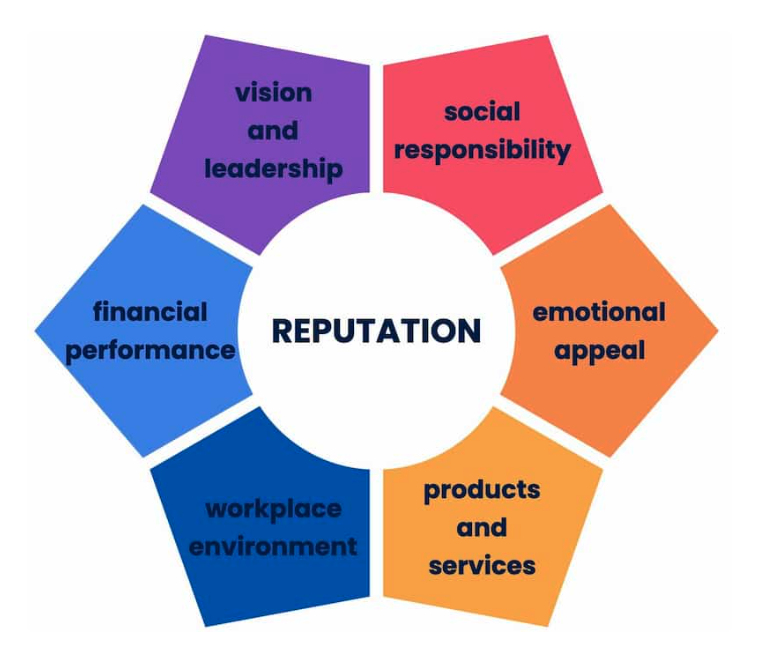An online presence can make or break your company’s reputation. And this uncertainty should in no way mean that your efforts to grow digitally as a brand take a back seat.
A solid digital footprint gives you a platform to engage and connect with your customers and employees. It lets you look at your customers from unperceivable aspects and sets you apart from your competitors.
But, at the same time, a brand’s online presence is a breeding ground for negative reviews and open judgments. That’s when reputation management becomes truly essential.
💡 Read Brand Reputation 101: Monitoring, Analysis, and Management Tools
The following guide will help you master corporate reputation management and to craft a winning strategy.
What is Corporate Reputation Management?
Corporate reputation management is when a company inspects each and every facet of its online presence and improves how customers and employees interact with their brand.
A company’s online presence is an amalgamation of reviews — both positive and negative, ratings, opinions, feedback, and more. And proper corporate reputation management can help counter the negative aspects, and promote positive feedback, thereby setting a narrative for the brand and broadening its reach.
But reputation management is more complex than it may seem. Why? The plethora of online sites and forums make it quite challenging for most companies to handle what people have to say about the company.
So does this mean you overlook negative reviews and solely concentrate on the good ones? No. Monitoring, creating a responsive plan, and understanding the reviewer’s point of view, among others, can help you run a successful company that’s unhindered by occasional bad reviews.
Why is Reputation Management Important?
Online reviews have a huge impact on the audience’s purchase decisions. Reviews on company websites, social media sites, and several other online review portals influence potential customers by either turning them into buyers or repelling them altogether.
So, here are some numbers to prove how corporate reputation management and a substantial digital presence make a huge difference:
- 30% of global web traffic results from online searches, and most of them were diverted to different business websites.
- The power of word of mouth and online reviews – 93% of users read online reviews to research a service or product before making a purchase. You can win brand loyalty and get more recommendations from your existing customers by investing in reputation management techniques.
- 4 out of 5 customers change their decisions when they encounter a negative brand review. Therefore, a well-crafted reputation management strategy can help curb negative reviews and increase trust.
- Ensure you pay attention to positive and negative reviews and respond quickly. A Bright Local survey of 2022 suggests that 89% of customers are highly likely to use a business that responds to all of its online reviews.

As a result of good corporate reputation management, you can achieve:
- Better customer retention and easier acquisition.
- Increased sales through word-of-mouth, positive reviews, and ratings.
- Attraction and retention of top-quality talent.
- Tap into newer market segments and surpass competitors.
- Create a brand identity and voice.
Now that you’re aware of the power your company’s reputation holds, let’s understand the primary ingredients that make up a good reputation management strategy.
Read Corporate Reputation: What is it and How to Protect it
Key Elements for Reputation Management
Before we dive into creating an exceptional corporate reputation management strategy, you must know that it’s primarily based on two key principles:
1. Monitoring
Analyze and continuously monitor every review source and be aware of what your audience says about your company. Your audience includes existing and prospective customers, visitors, employees, media, influencers, and competitors.
Read 9 Crucial Brand Awareness Metrics to Track
2. Responding
Actively respond to all kinds of reviews, feedback, and criticism. Have measures in place to make sure your responses are 100%. Doing this helps you improve your brand identity and showcases your company as reliable and relevant.

So, these will be the two core elements of your reputation management strategy. And now, let’s get to building one.
Read Why Brand Reputation Monitoring Is Important (And How to Do It Right)
How to Create a Strategy for Corporate Reputation Management
Step 1: Decide what you stand for
The very step you must take before foraying into reputation management is deciding what you wish to stand for and be known for. Because a business is much more than the products or services it sells. It’s also about how you treat customers and employees, your belief systems, your conviction to make society a better place, and more.
Why is defining what you stand for important? Because ultimately, customers’ purchase decisions and employees’ happiness depends upon the company’s trustworthiness and reliability. Amazon, for instance, has been a go-to online shopping platform across the globe, thanks to its super-fast deliveries and reliable return policies.
Here are more such examples you could choose from:
- Be known for having the most affordable products or services in your industry.
- Have an omnichannel 24/7 customer support.
- Have a reputation for being the face of a cause or a social/environmental issue.
- Own a niche product and be the best at it while promoting it to a specific target audience.

So no matter what stage your company is at or what you decide to stand for, make sure it is impactful and evident.
Read Ultimate Guide for CEO Reputation Management
Step 2: Ensure consistent message across all channels
You now know what you stand for, and to see effective results, you must be consistent across all platforms. The message you deliver and its tone and voice has to be unwavering, be it on social media, blogs, your websites, or ads.
Start by educating your employees as they’re the face of your company. Let them be clear on the message they sell and what your company plans to achieve out of it. Next, regularly monitor content for your social media platforms before publishing them.
Highlight your uniqueness and let your customers remember you by your resonating message. Start creating content that fits into your reputation-supporting marketing and social media strategy, and never try to copy your competitors.
Step 3: Monitor your reputation by using social listening
What do you think shapes your reputation? Is it online reviews on sites like G2 or Trustpilot, or social media conversations, or articles talking about your company’s employee experience? It’s a mix of everything. So, the only way to control and respond to any such mentions is by monitoring and tracking them.
And listening is the first step to active monitoring.
Known as social listening, it is the process of monitoring your company’s online mentions on multiple platforms. If you have a physical office, you will likely have Google reviews and ratings already. Or if you have a software product, you may be rated on G2 or Capterra — you get the point.
But it is nearly impossible for any company to single-handedly, day in and day out, manually monitor their brand mentions to reduce response times. You can get the help of an external tool to do the social listening for you and monitor and track every single brand mention using targeted keywords.

Step 4: Devise a response plan
Responding to your company’s mentions means you take total responsibility and make an effort to improve your customer and employee experiences with your brand. But without a developed response plan, things can go haywire quickly.
So, here are some things to consider while devising an ideal response plan:
- Who is responsible for monitoring company-related reviews and mentions across the internet?
- How are you going to handle positive and negative comments?
- What is your timeline for responding to comments and reviews?
- Do you have someone who can handle harsh criticism and knows the steps to counter them?
Remember that downplaying negative comments can cause a bad reputation for your company. So it’s equally important to respond to both positive and negative reviews politely.
Step 5: Understand the sentiment behind the comments
Timely response to reviews and comments is just not enough. Understand the intent and the sentiment behind those comments. What led them to say that? Did you have a role to play?
An effective method is to have a one-on-one phone conversation with an angry customer. This way, you get immediate feedback, and your customer is now satisfied that you’re ready to rectify their issue.
But when negative trends get out of hand, you could use sentiment analysis tools to help you analyze and fix problems on the go.
Step 6: Become easy to reach
Customers and employees love it when you’re just a phone call away. Being easily accessible can save your reputation and a ton of bad reviews.
Having an international phone number boosts your customer support reputation worldwide. Imagine the number of negative reviews that could be stopped if the customers and businesses had a productive conversation.
Step 7: Follow through and measure results
Follow up on your responses to check if your promises to negative comments actually took effect. If not, your customers or employees would follow up on their negative reviews with how you over promised and under delivered.
Next, measure your results. Tracking gives you a clear picture of whether or not your strategies are working. A monitoring tool can help you identify flaws, learn from mistakes, and continue building on strategies that show the best results for your company’s online reputation.
How do you know if your reputation technique is showing results? An effective strategy lets you double your positives and reduce negatives significantly.
Step 8: Prioritize relationship building
A good reputation management strategy insists on building better relationships with customers and employees through empathetic responses.
Make the person feel heard and understood by providing a personalized response and solution. Also, ensure your responses are quick. For more complex issues, try to reach people via email or phone.
Read Top 5 Reputation Management Tools
Wrapping up
The ever-so-widening digital landscape has reiterated the need to watch what your audience says about your company and be at the forefront of the increasing competition. Learning your audience’s thoughts impact every other function, such as marketing, branding, hiring, and growth.
Building a good corporate reputation sure does take a lot of time and effort, but it hugely benefits your company in the long run. Craft a strong strategy and use the right tools to protect your brand.
Filip Halek is a content writer based in Bratislava, Slovakia. He’s dedicated to creating compelling messaging for the next generation of business communication tools.


